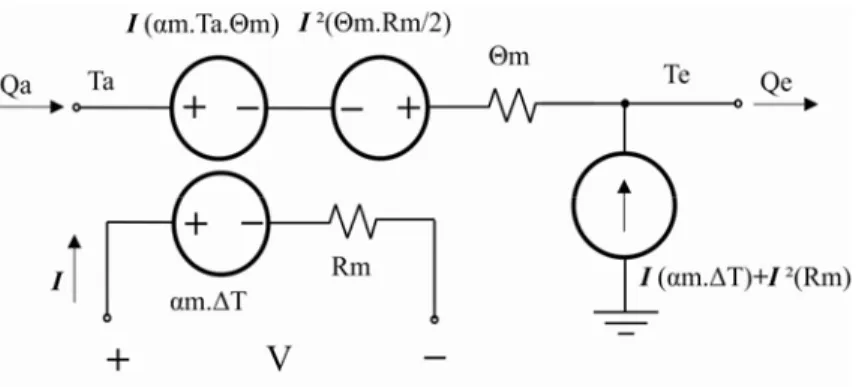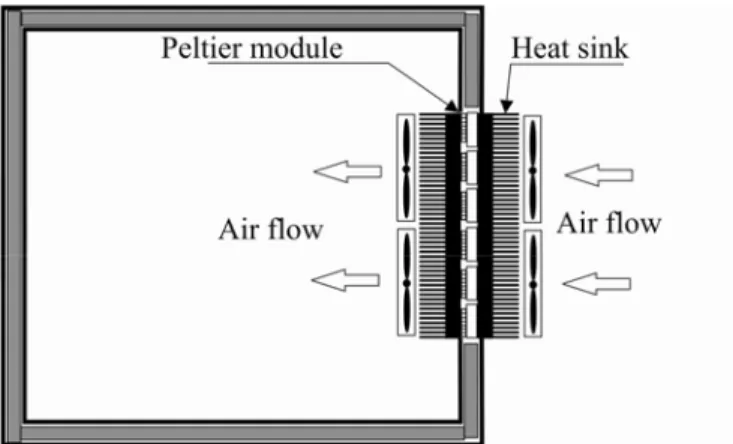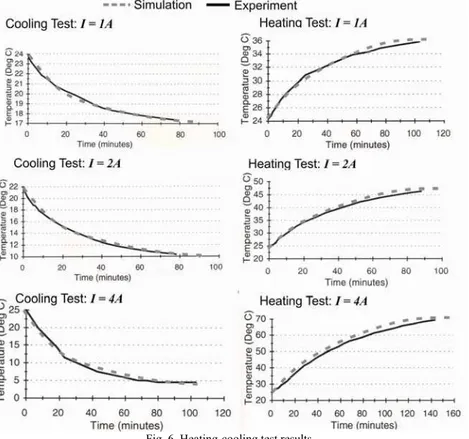ISSN : 0975-5462 Vol. 3 No. 2 Feb 2011
TESTING AND SIMULATION OF SOLID
STATE HEATING AND COOLING
CHAKIB ALAOUI*
College of Computers and Information Technology Taif University, KSA
chakib@tu.edu.sa Abstract:
The latest model of solid state Peltier thermoelectric pumps was reviewed and improved. A heating-cooling chamber was designed and fabricated by using the Peltier modules, and its equivalent circuit was extracted and simulated. This chamber was tested under various values of input power in both cooling and heating modes of operations. The experimental results were compared with the proposed model. This model is proven to be accurate and can be extend to any Peltier based thermoelectric system for simulation, and can be used to simulated thermoelectric systems based on these modules.
Keywords: Peltier effect heat pumps; Coefficient Of Performance; Spice Model.
1. Introduction
The Peltier effect thermoelectric heat pump is a semiconductor based electronic component that functions as a heat pump. Just by applying a low DC voltage to this module, one surface gets cold and the other surface gets hot. And just by reversing the applied DC voltage, the heat moves to the other direction. Thus this thermoelectric device works as a heater or a cooler.
The Peltier thermoelectric heat pumps have been used for medical devices [1, 2], sensor technology [3, 4], cooling integrated circuits [5], automotive applications and military applications.
This project is about the validation of a Spice model of the Peltier thermoelectric heat pump suitable for transient simulations. In order to verify this model, a cooling chamber was designed and fabricated. It has a temperature range from 0°C to +100°C, and a storage volume of 11x29x33 cm³. Its inside temperature was measured under different rates of input power and its performance was calculated. This Spice compatible model will help designers predict the thermal behavior of system using Peltier thermoelectric heat pumps.
2. Peltier Effect Cooling/Heating
The thermoelectric heat pump was discovered by a French watchmaker during the 19th century. It is described as a solid state method of heat transfer generated primarily through the use of dissimilar semiconductor material (P-type and N-type).
Like conventional refrigeration, Peltier modules obey the laws of thermodynamics. Basically the refrigerant in both liquid and vapor form is replaced by two dissimilar conductors. The solid junction (evaporator surface) becomes cold through absorption of energy by the electrons as they pass from the low energy level to the high energy level. The compressor is replaced by a DC power source that pumps the electrons from one semiconductor to another one. A heat sink replaces the conventional condenser fins, discharging the accumulated heat from the system. The following table outlines the differences and similarities between the thermoelectric module and the conventional refrigerator.
The absorbed heat qa, the emitted heat qe and the input electrical power P used to operate the modules can be described from equations (1).The heat pumped is the sum of the Peltier effect term (αm.T.I), the heat conduction term (C/Θm) and the Joule effect term (I²Rm). It is conventional to leave out the effect of the Thompson phenomena because it is negligibly small. Additionally, it is common practice to apply equivalent electrical circuit scheme in one-dimensional heat transfer problems [12].
(1)
ISSN : 0975-5462 Vol. 3 No. 2 Feb 2011 Where: Rm is the resistance of the module, αm is the Seebeck-coefficient of the pn junction, Θm is the thermal resistance, Te is the absolute temperature of the heat emitted, Ta is the absolute temperature of the heat absorbed and ∆T = Te – Ta. qa and qe represent the amount heat absorbed and emitted from the module. Finally, V and I are the voltage and the current from the input power supply.
The Coefficient Of Performance, or COP in short, describes the efficiency of the heat pump when working in cooling and in heating modes. The COP is expressed by equations (2).
COP qa / P
Various equivalent circuits have been developed to model the behavior of the Peltier heat pump [10,11]. The purpose of these models is to simulate the behavior of Peltier modules in CAD tools like Spice, and hence to predict the amount of heat that it can transfer. Figure 1 shows the equivalent circuit of the thermoelectric heat pump based on equations for a- and e-junctions [11].
Fig. 1. The equivalent circuit of the thermoelectric heat pump.
Figure 2 shows a modified equivalent circuit of the Peltier module. This model is made of two current dependent voltage sources, two current dependent current sources and two lumped parameters. It can be easily implemented on Spice since all the elements exist on its library. The parameters αm, Θm and Rm can be directly calculated from the manufacturers data sheet according to equations (3). This circuit is comparable to the proposed Pspice equivalent circuit by [10]
Fig. 2. The modified circuit of the thermoelectric heat pump.
This model is made of two current dependent voltage sources, two current dependent current sources and two lumped parameters. It can be easily implemented on Spice since all the elements exist on its library. The parameters αm, Θm and Rm can be directly calculated from the manufacturers data sheet according to equations (3). Where ∆Tmax is the largest temperature differential that can be obtained with Imax and Vmax. Th being the temperature in the hot side.
(2)
ISSN : 0975-5462 Vol. 3 No. 2 Feb 2011 3. Evaluation of the model
3.1. Design and fabrication of a heating-cooling chamber
The main body of the refrigeration chamber has a dimension of: 0.11x0.29x0.33 m³ strongly insulated to minimize heat loss to the ambient air. In the cross section of this chamber, three layers exist: two walls of aluminum separated by an insulating material of 3 cm of thickness. Refer to figure 3.
Fig. 3. Heating-cooling chamber
High density heat sinks were specially fabricated for this project. They are made of Aluminum and are 350 x 75 x 39 mm³, with 21 fins along their length and weight is 1500 Grams. Their specific heat is 0.963 J/g.°C. The “hot” surface of the thermoelectric heat pump must be attached to a heat sink that is a capable of carrying away both the heat pumped by the modules and the heat generated by the Joule effect.
The “cold” surface is also attached to another heat sink that will carry away the cold air, hence decreasing the temperature differential ∆T, and then making the thermoelectric more efficient.
A “spacer block” is also put between the modules and the heat sinks. Its thickness, of 18 mm, separates the “hot” heat sink from the “cold” one, which yields to a maximum heat transfer. Peltier modules from Ferrotec [1] were used in this experiment. Their specifications are shown in table 1. Their thermal resistance, Seebeck coefficient and internal resistance were calculated according to equations (3):
Rm = 1.6Ω, Θm = 1.25 K/W and αm = 0.054 V/K for Th = 300K.
Table 1: Peltier thermoelectric module technical specifications.
Module number Imax Qmax Vmax DTmax
6300/127/085 8.5A 80W 17.5V 72°C
(3)
ISSN : 0975-5462 Vol. 3 No. 2 Feb 2011 3.2. Simulation of the heating-cooling chamber
The equivalent circuit of the chamber was implemented on Spice according to the proposed model. Figure 4 corresponds to the cooling mode of operation, and figure 5 corresponds to the heating mode of operation. The lumped parameters R’s and C’s are defined as follows:
· R1: Thermal resistance of the chamber’s wall · R2, R5: Thermal resistance of the heat sink + fan · R3, R4: Assembly’s thermal resistance
· C3, C4: Heat capacity of alumina ceramic plates and pellets of the Peltier modules. · C2, C5: Heat capacity of the heat sinks
· C1: Heat capacity of the chamber · TSSHC: Temperature inside the chamber
· Ta/Te: Cooling/Heating temperature at Peltier module
· Ta’/Te’: Cooling/Heating temperature at Peltier module after assembly
Fig. 4. Heating-cooling chamber circuit – Cooling mode of operation.
Fig. 5. Heating-cooling chamber circuit – Heating mode of operation
3.3. Experimental evaluation of the heating-cooling chamber
The thermal output power was calculated by using the laws of thermodynamics [6-7]:
Heat given by modules = [Heat gained by aluminum chamber + Heat gained by the air inside + Heat gained by heat sinks + Outside losses]. First order equations were used to calculate the COP. The outside losses are neglected at the beginning of the experiment when the temperature increases linearly with time.
Heat gained by the air: P(air)
P(air).dt = n.c’.dT with:
P(air) : Output power (W)
n: Number of moles (0.4616 mole) c’: Molar heat capacity (20.93 j/mole.°K) dt: t2 – t1 (sec)
Then: P(air) = 9.65 dT/dt (W)
(4)
ISSN : 0975-5462 Vol. 3 No. 2 Feb 2011 Heat gained by the chamber and the heat sinks: P(Aluminum)
H = m.c.dT with
H: The gained energy (J)
m: Total mass (Chamber = 2200g, Heat sinks = 1875.75g) = 4048.75 g c : Specific heat (0.963 J/g.°C for Aluminum)
P(Aluminum) = H / dt = 3908.6 dT/dt
3.4. Experimental results
The chamber was run for many values of input current. The temperature, time and input electrical power were measured. The simulation and experimental results are shown in figure 6. The obtained COP for the different current is shown in tables 2 and 3. The experimental results show a good fit of the Spice simulation with the experimental data.
Fig. 6. Heating-cooling test results.
Table2: Cooling Performance Results
Input Current (A) Input Power (W) Output Power (W) COP(Experimental) COP(Simulation)
1 12.89 24.61 1.91 2.04
2 52.62 43.06 0.818 0.98
3 119.58 55.37 0.463 0.51
4 216.56 55.38 0.255 0.32
Table3: Heating Performance Results
Input Current (A) Input Power (W) Output Power (W) COP(Experimental) COP(Simulation)
1 14.2 30.76 2.16 2.24
2 58.5 70.75 1.21 1.31
3 135.87 138.48 1.018 1.27
4 245 161 0.66 0.86 (5)
ISSN : 0975-5462 Vol. 3 No. 2 Feb 2011 4. Conclusion
A model has been developed to simulate the transient state for a Peltier thermoelectric module. This model uses controlled sources and lumped parameters, hence can be easily simulated with simulation software like Spice. The model parameters can be calculated by using the manufacturer’s datasheet.
In order to validate this model, a heating and cooling chamber using Peltier modules was designed and fabricated. The overall system was tested and simulated with Spice under various values of input currents. The result is a good fit between the simulation and the experimental data.
This model can easily expanded with lumped parameters R’s and C’s representing the thermal resistance and the heat capacities of a thermal system in order to be simulated in Spice.
References
[1] ITI Ferrotec: Thermoelectric product catalog and technical reference manual, catalog No. 100.
[2] J. C. Reynaud, F. Martini, “A new interface chamber for the study of mammalian nervous tissue slices”, Journal of Neuroscience Methods 58(1995) , pp. 203-208.
[3] P. Ancey, M. Gshwind, “New concept of integrated Peltier cooling device for the preventive detection of water condensation”, Sensors and Actuators B 26-27 (1995) pp. 303-307.
[4] H. Stachowiak, S. Lassue, “A thermoelectric sensor for fluid flow measurement. Principles, calibration and solution for self temperature compensation”. Flow, measurement and instrumentation 9 (1998) pp. 135-141.
[5] E. D. Baetselier, W. Goedertier, “A survey of the thermal stability of an active heat sinks”, Microelectron reliability, Vol 37. No. 12 (1997), pp. 1805-1812.
[6] P. Atkins, “Physical Chemistry”, W.H. Freeman and Company, (1994). [7] Warren L. Mc Cabe, “Chemical Engineering Series”, McGraw-Hill Inc. (1993).
[8] B. K. Bose, “Modern Power Electronics: Evaluation, Technology and applications”, IEEE Press (1991). [9] AAVID Thermal Technologies, Inc. Product selection guide (1995).
[10] S. Lineykin, S. B. Yaakov, “Pspice Equivalent Circuit of Thermoelectric Coolers”, Power Electronics Specialists Conference, PESC ’05. IEEE 36th, (2005).
[11] J. Chavez, J. Ortega, J. Salazar, A. Turo, and J. Garcia, “Spice model of thermoelectric elements including thermal effects,” Proceedings of the Instrumentation and Measurement Technology Conference, 2000, pp. 1019 - 1023.
[12] S. Franco, “Electrical and Power Engineering Series”, McGraw-Hill, Inc. (1997). [13] J. P. Holman, Heat transfer, 7th ed., London: McGraw-Hill, (1992)
[14] C. Alaoui, Z. Salameh, “Solid State Heater Cooler: Design and Evaluation”, Large Engineering Systems Conference on Power Engineering (July 2001).
Biographical notes
Chakib Alaoui is Assistant Professor at the faculty of computers and Information Technology at Taif University, KSA. He obtained a PhD degree from the University of Massachusetts, Lowell in 2001. His interests are in the area of analog, digital and power electronics, wind and photovoltaic energy conversion and electric vehicle technology.



